Best Disability Insurance For Sign Language Interpreters | We Discuss How This Important Insurance Protects Your Income And Wealth
Updated: April 12, 2024 at 9:39 am
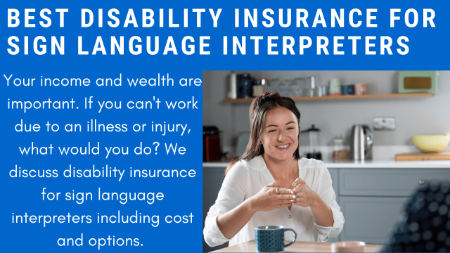
Sign language interpreters usually don’t wake up in the morning and think, “Gosh, I need some disability insurance!”
Am I right?
Being a sign language interpreter can be a very tough job, but a rewarding one both emotionally and financially.
However, have you ever thought about what could no longer do your job?
What would happen if you became sick, ill, injured, and disabled?
How would you pay your bills if you could not work?
Moreover, how your lack of income affects your family?
What will happen to your future, financially and emotionally?
These are serious questions that need answering. As we will discuss, a disability happens at any time.
Disability quickly affects your future plans and the lifestyle you worked so hard for.
Here is what we will discuss:
- #1 Reason Why You Need Disability Insurance?
- How Disability Insurance Protects Your Wealth
- Elements Of A Strong Disability Insurance Policy
- How Underwriting Affects Your Plan
- The Best Disability Insurance Available
- What If I Have A Policy Through My Employer?
- How Much Does All This Cost?
- Now You Know How To Protect Your Wealth With Disability Insurance
Let’s jump in and discuss the #1 reason why sign language interpreters need disability insurance.
#1 Reason Why Sign Language Interpreters Need Disability Insurance
Disability insurance is, simply, a type of insurance that pays you a dollar benefit if you can’t work due to illness or injury. The benefit is a percentage of the salary or income you make (more on that in a minute).
Do you need disability insurance?
Many sign language interpreters tell me, “no”, but if you:
- Make money, and
- You use that money to pay your mortgage, groceries, and other needs, and
- If you and your family would be in a tough financial situation if you could not work, because of an injury or illness, then:

It is really that simple.
Essentially, if you will struggle to pay the bills upon an illness or injury, you probably need disability insurance.
3 Reasons Sign Language Interpreters Need Disability Insurance
There are really 3 reasons why sign language interpreters need disability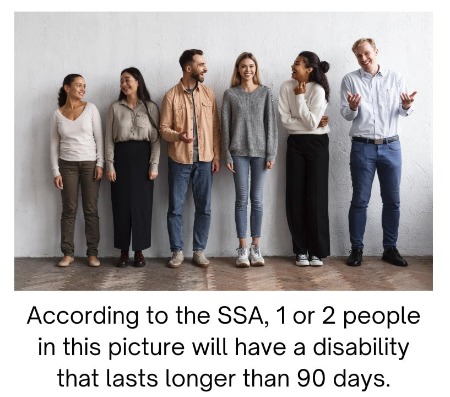 insurance. We’ve talked about the first 2 ad nauseum in many other articles.
insurance. We’ve talked about the first 2 ad nauseum in many other articles.
Here are the first 2:
- A disability happens way more than you think – this is true. Government stats report that a 20-year-old today has a 1 in 3 to 1 in 4 chance of experiencing a disability greater than 90 days, before full retirement age.
Remember that anything injury or illness-related can be a disability if it prevents you from doing your job as a sign language interpreter. It’s not just “wheelchair-related” disabilities. A disability for a sign language interpreter could be depression, COVID-19, MS, a severe injury, and on and on…
- A disability can last a long time. There are stats stating that the average disability is 3 years. Maybe. Personally, I think that information is a bit flawed as it probably includes people who don’t want to go back to work. The claims departments I speak with tell me their average claims are around 18 months.
As a sign language interpreter, you see this every day. People who are deaf or hearing impaired are considered disabled, even if they are working.
Regardless, can you survive financially without receiving a paycheck or income for 1, 2, or 3 years and more?
Think hard about that. This brings us to our #1 reason why sign language interpreters need disability insurance.
Here’s The #1 Reason: More Important People Rely On You
 Your clients are very important. There is also a group of people who are more important. Who can be more important than my clients, you think? They pay my income.
Your clients are very important. There is also a group of people who are more important. Who can be more important than my clients, you think? They pay my income.
True. They do, but they don’t love you as your family loves you. By far, if you have a family, your spouse and children rely on you more than you think. They love you more than anything.
If you are disabled without disability insurance, there will be tough questions that need answering and tough decisions need to be made.
Would you and your family be able to continue your standard of living without your income? If not, what is “plan B”?
Would your spouse have to work or work more? He or she would have to. How?
Would you need to sell your home to make ends meet? (Truthfully, I had a person call me about this. Her husband got disabled and was the breadwinner. With no money coming in, they couldn’t pay the mortgage. Sadly, no. It was too late. This is why disability insurance is way more important for “mortgage protection” than life insurance.)
Who could be flexible with the children? Would you have the money to hire someone to take care of the kids?
The tough questions can go on and on.
Disability insurance answers these questions. With disability insurance, you have peace of mind knowing that you have a plan – and income – in place should the unexpected happen.
How Disability Insurance Protects Sign Language Interpreters’ Wealth
Many professionals ask me how disability insurance protects their wealth. Sure, they know how it replaces income, but not wealth.
As a CFP® Professional, I explain with this easy example.
Sign language interpreters earn $85,000 annually on average. Let’s average that to about $7,100 monthly.
What if you were disabled for 2 years? What would happen financially?
Well, you would lose $170,400 over that 2-year period (24 X $7,100 per month ).
Where would that money come from to pay $170,400 over 2 years?
This is why I asked all those questions at the beginning of the article. In order to replace $170,400, would your spouse have to work more? If so, what gives? (The kids, the house…something has to.)
Where would you get $170,400 to cover 2 years of expenses? (Note: I am aware that your expenses may be less than this, but the question still remains – where will you get this money?)
Most people tell me from their retirement savings. That’s assuming you have enough in your retirement accounts. Here’s an example.
Example Of How Disability Insurance Protects A Sign Language Interpreter’s Wealth
OK, first let’s assume you saved enough. Let’s also say you are a female sign language interpreter, age 40, and make $100,000 gross or $60,000 after taxes and deductions. You have $75,000 saved through your 401k, and you contribute $500 each month to your 401k. Retirement for you is at age 65.
You are disabled. However, you don’t have disability insurance.
So, gone is your monthly 401k contribution. But, you aren’t worried about that. Your main worry is money. You just need money to help pay the bills.
You turn to your retirement savings and request distributions from your 401k. These distributions are taxable and subject to a penalty. But, that isn’t important right now. You need the money.
Let’s compare how your 401k would look with and without a disability.
Assuming an 8% return, without a disability, you would have accumulated about $1,110,000 at age 65.
But, because you are disabled, you exhaust the $75,000. It’s gone. You are still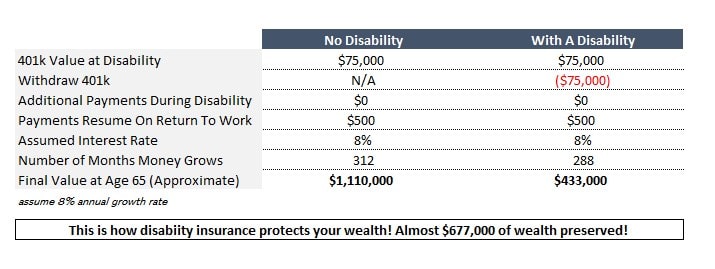 disabled. Your spouse works more, and the family helps with the kids. You take out a home equity loan to pay for things. Thankfully, the mortgage is paid. While you are grateful; however, it is a financial strain and stressful. It makes you worried.
disabled. Your spouse works more, and the family helps with the kids. You take out a home equity loan to pay for things. Thankfully, the mortgage is paid. While you are grateful; however, it is a financial strain and stressful. It makes you worried.
After 2 years, you are back at work. You’ve used $120,000 ($5,000 per month) from your home equity loan and 401k. However, you are 2 years older. Moreover, you don’t have retirement savings anymore, so you start over.
You contribute $500 each month. At age 65, you have about $433,000.
By raiding your investments and not having income protection (i.e. disability insurance), you’ve lost $677,000 of wealth!
That is because the $75,000 saved could not compound for another 25 years. Because it was gone.
What Happens If You Had Disability Insurance?
If you had disability insurance, you would have been much better off.
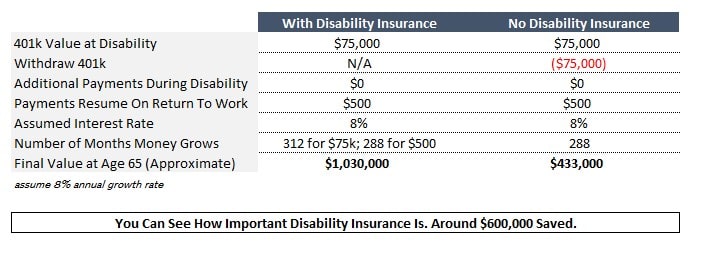 Sure, you would not have contributed $500 each month for 2 years ($12,000).
Sure, you would not have contributed $500 each month for 2 years ($12,000).
And, yes, you have to pay a premium for disability insurance. But, that cost is peanuts compared to the wealth loss.
Moreover, your investment still would have compounded those 2 years while on disability.
So, if you had disability insurance, you would have ended up with approximately $1,030,000 at age 65.
What, you exclaim!
Yes, and remember…this is a 2-year disability. What if your disability was 5 years or more?
This is how disability insurance protects your wealth!
As stated earlier, the cost of this is cheap. Much cheaper than the alternative of raiding your 401k and savings. We discuss estimated costs further in the article. However, essentially, depending on various factors, disability insurance may cost around $5 per day or less.
$5 cost per day versus a savings loss of $600,000 (in our example). While our example is simple, I think you see the magnitude of financial loss and how disability insurance protects your wealth.
Elements Of A Strong Disability Insurance Policy For Sign Language Interpreters
Hopefully, we have made a great case showing that sign language interpreters need disability insurance.
I’m ready to enroll now, John, you say.
Sounds great. First, though, let’s discuss the characteristics that make a strong policy.
You see, there are many policies that offer limited benefits.
You don’t want to mess with those policies. The worst thing that could happen is you file a claim, expect a payout, and don’t receive one.
So, let’s first discuss the basic elements needed in any disability insurance policy for sign language interpreters. We will then discuss additional insurance options and riders.
Disability Insurance Policy Basics
I speak to sign language interpreters about disability insurance every day. There are 2 major sources of confusion that these professionals hear from elsewhere. These confusing components are, essentially, “the basics”, but if you get these wrong, you could be in for a surprise when it comes time to make a claim.
The first is the waiting period or elimination period. In terms of disability insurance, it is not the period of time before your policy is in effect. That is correct for other types of insurance, but not for disability insurance.
The elimination period is the length of time – a waiting period – that elapse before you are eligible for disability benefits. It happens upon a claim. For example, a 90-day elimination period means your benefit period begins after 90 days of disability. On the 91st day, you are eligible for benefits. Typically, you receive your first benefit 30 days after that.
This means you need to have adequate savings to carry you and your family until benefits begin.
The second is the benefit period. The benefit period starts when you are eligible for benefits and lasts until the end of the benefit period or if you return back to work, whichever occurs first. It is not the maximum timeframe that your policy exists. As long as you pay the premiums, you will have the policy until age 65 or 66 – at retirement age.
Typically, the maximum benefit period available for sign language interpreters is to age 67.
Remember, the average disability claim is 35 months (internet stats) or the 18-24 months (from claims departments). So, even a 5-year benefit period works.
3 Provisions That Make A Formidable Plan For Sign Language Interpreters
If you spend premiums on a disability insurance policy, you want to make sure you get paid upon a claim.
In my opinion, there are 3 disability insurance provisions that make a formidable plan.
I call these “non-negotiables”. Let’s discuss these now.
#1 The Definition Matters…
The definition of disability matters. You generally want some type of “own occupation” definition. However, I will explain more later.
There are two “degrees” of the own occupation definition: “true” own occupation and the “modified” own occupation definition. (There are other own occupation definitions, but these are the two most common.)
Here’s what they each mean. The “true” own-occupation definition means:
- you will receive a disability benefit based on your inability to do your job (as a sign language interpreter), AND
- also work simultaneously in another job for an earned income (should you decide you can).
In other words, you can continue to work in another occupation while receiving disability benefits for the inability to do your job as a sign language interpreter.
So, if you can’t use your hands, but you can greet people at Walmart, you will receive disability benefits in addition to your earnings as a Walmart greeter.
Modified own occupation is a bit different. You will receive a disability benefit based on your inability to do your job. However, you can’t work in another job. So, if you worked as a Walmart greeter, you won’t receive disability benefits under the modified own occupation definition. This is a good definition, too.
Be Aware Of The Any Occupation Definition
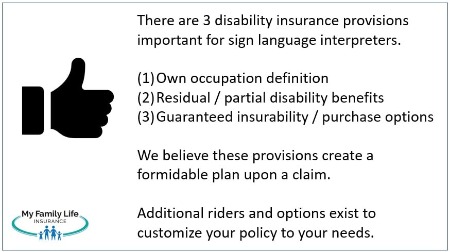 Finally, there is the stringent “any” occupation definition. This means, simply, if you can work in any gainful occupation (for which you are reasonably suited, considering your education, training, and experience), the carrier denies your benefits. So, under this definition, you won’t receive a disability benefit based on your education and experience as a sign language interpreter because the insurance carrier says you can work as a Walmart greeter.
Finally, there is the stringent “any” occupation definition. This means, simply, if you can work in any gainful occupation (for which you are reasonably suited, considering your education, training, and experience), the carrier denies your benefits. So, under this definition, you won’t receive a disability benefit based on your education and experience as a sign language interpreter because the insurance carrier says you can work as a Walmart greeter.
Do you want this definition? As a sign language interpreter, probably not.
However, let’s say you have a long-term problem with your left wrist or arm because of work repetition. Can you do another job? If you can, then the any occupation plan won’t pay a benefit.
Personally, I always like to play it safe and have clients’ policies contain the “modified” own occupation definition.
#2 Residual / Partial Disability Benefits
This rider will pay a benefit if you return to work in your occupation, and you experience an income loss of 20% or more compared to your pre-disability income. Usually, the amount of disability income you receive is a percentage of your total monthly disability benefit. For example, let’s say you return to work and experience a 40% income loss. If your monthly disability benefit is $4,000, you will receive $1,600 ($4,000 X 40%).
Why would you need this rider? Most disability insurance policies allow partial disability benefits upon total disability first. This means if you are only partially disabled (i.e. you can still work but not full-time), you will not receive any benefits until you have met the carrier’s requirements for total disability first. But, you are partially disabled, not totally disabled. Without this rider, you won’t receive any partial disability benefits until you have met the total disability requirements first. Ugh!
Typically, this rider circumvents the total disability requirement and allow you to receive benefits immediately (after you satisfy the elimination period).
Here is a very easy example. You lose feeling in your wrists and fingers. The doctor says you need to rest and limits your work to 2 days per week. Without this rider – or a plan that has a partial benefit without a total disability requirement first – you would not receive any disability benefits because you are still working.
#3 Guaranteed Purchase Option
This option allows you to obtain the coverage you need now with the option to purchase additional coverage in the future without evidence of good health. You just need to show your salary (through a W-2 or your tax return).
In other words, you can buy more disability insurance as your salary grows (subject to carrier income and coverage limits) with no underwriting.
How great is that?
You can develop type 2 diabetes, develop RA, or get hurt. It doesn’t matter. You can still buy more disability insurance because of no underwriting.
Carriers allow additional purchases every 2 years up to age 55. (You do not need to wait 2 years if you had a life change, defined as a marriage the death of a spouse, divorce, or birth or adoption of a child; Instead within 3 months of a life change, you may purchase additional coverage.)
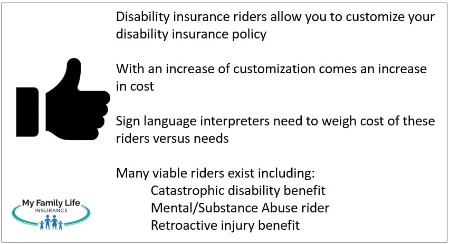 Optional Disability Insurance Riders For Sign Language Interpreters
Optional Disability Insurance Riders For Sign Language Interpreters
After these 3 provisions, you can customize your policy any way you want. There are many disability insurance riders available.
Like purchasing options in a new car, purchasing riders increases the cost of your policy.
That doesn’t mean it is a bad thing. You just want to make sure it fits your needs.
You can add optional riders at an additional cost to your policy to best fit your needs and budget. Some popular rider options for sign language interpreters include:
- Retroactive injury benefit
- Mental/nervous benefit for the duration of the benefit period
- Catastrophic disability benefit
Contact us or review our article on disability insurance riders. We will be happy to answer any questions you have.
Disability Insurance Underwriting For Sign Language Interpreters
It’s important to understand how disability insurance carriers underwrite your application.
Oh, I just went through the life insurance process. I know how it works, you say.
Great. But, disability insurance underwriting is completely different.
Carriers aren’t insuring your mortality. They are insuring your morbidity. In other words, the risk of a disabling accident or illness and paying you a percentage of your salary.
So, carriers look at the following attributes in an application.
When it comes to underwriting, carriers look at your:
- Age
- Health
- Income / Salary
- Occupation
- Other hazards and lifestyle situations
Underwriting Specifics
Age is a factor. The older you are, the more expensive the policy – all things being equal, of course. This is why you want to start your policy as soon as possible.
Obviously, your health matters. If you have a chronic illness or had a severe injury in the past, likely that illness or injury won’t be covered. Additionally, carriers can limit benefits based on any health conditions. For example, if you take any anxiety or depression medication, nearly all the carriers limit the waiting period to a minimum of 90 days.
As we mentioned before, carriers insure a percentage of your salary. This percentage is usually 60% of your gross salary.
Your occupation matters as well. All the disability insurance carriers classify your occupational disability risk. The classification table is usually a 1 to a 5 (or 6 with some carriers). An occupation with a class 1 is most risky while an occupation with a class 5 is least. For example, carriers classify a construction laborer at a 1 and an accountant at a 5.
Usually, carriers classify the sign language interpreter’s occupation at a class 3 or a class 5 depending on your occupational duties.
Finally, carriers also consider other situations and lifestyle choices like hazardous hobbies. Do you like to rock climb or use marijuana? If so, that hobby will be excluded from your policy.
What Do The Carriers Do With The Information?
The underwriters review all this information and make an approval decision or not. They routinely look up your medical background in the MIB), prescription drug databases, driving records, tax records, etc.
As we discussed, certain situations may limit benefits, benefit period, and/or waiting periods. They may also increase premiums to compensate for an increased disability risk. For example, if you use marijuana, some carriers will rate your policy (i.e. increase the premiums).
Nevertheless, if your benefits are modified in any way, it still makes sense to purchase the policy. We discuss more in our disability underwriting guide.
The Best Disability Insurance For Sign Language Interpreters
You are probably wondering who we like to work with. First, we work with many disability insurance carriers. So, we are sure we can find one that meets your needs and budget.
Second, the “best” is only the best one that fits your needs, situation, and budget. We don’t try to fit a square peg in a round hole with such important insurance coverage.
However, not all carriers insure sign language interpreters the same. Some carriers classify sign language interpreters at a class 3 while we know of one that classifies at a class 2.
The carriers we like insure sign language interpreters at a class 5. Moreover, there is no limitation of benefits.
Additionally, the carriers we like all have the:
- Own-occupation definition
- Partial disability benefits
- Guaranteed purchase options
And, additional options as we discussed. Moreover, the plans we like offer value-added benefits like retraining programs.
If you are Christian, we also work with a carrier dedicated to practicing Christians.
Contact us if you would like to learn more. We are happy to chat with you. Since we work with so many disability insurance carriers, I am sure we can find a carrier that meets your needs and budget.
Be careful of blindly applying online without knowing what you are getting yourself into. Buying directly online, currently, is the wrong way to buy disability insurance. Why? As we illustrated earlier, there are so many moving parts with disability insurance. How do you know what you are applying for is right for you? If you apply online without the aid of a reputable broker or agent, you don’t.
What If Sign Language Interpreters Have Disability Insurance Through Work?
John, great article, you say. I have disability insurance through work, and I am all set.
Most people do. However, you are unlikely “all set”.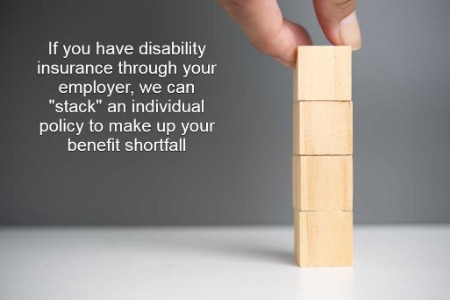
If your employer or union pays for your disability insurance, that benefit is taxable to you.
Additionally, if you pay the premium yourself with pre-tax money (i.e. through payroll), that benefit is also taxable to you.
What does this mean? It means if you make a claim and receive benefits. You receive a tax statement for the benefits paid to you. You then include the benefit amounts on your tax return. Therefore, it is a taxable benefit.
Ugh! My HR person never told me this!
Most don’t. Thankfully, adding an individual plan makes up for this shortfall.
Moreover, it doesn’t cost much.
Here’s an example.
Let’s say you are a 35-year-old woman and make $80,000 as a sign language interpreter. You have disability insurance through your employer. They pay 100% of your premium.
Your monthly benefit is $4,000, which is 100% taxable to you if you make a claim and receive a benefit.
You can receive an additional $1,3535 monthly benefit. It contains a 90-day waiting period and to age 67 benefit period.
It is also own occupation definition along with a guaranteed purchase option and partial benefits.
The cost is about $56 per month.
If she wanted a 5-year benefit period, the cost is about $37 per month.
In either case, you can see the extra protection is affordable.
The Premium Cost Of Disability Insurance For Sign Language Interpreters
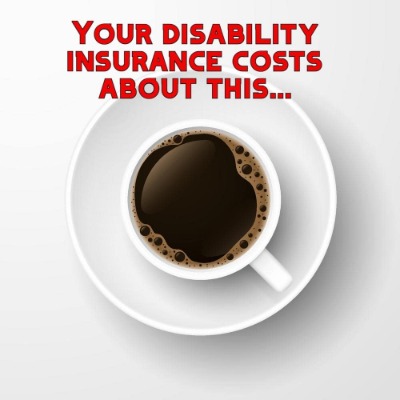 After all of this, how much does disability insurance cost for sign language interpreters? That’s the $1,000,000 question. Well, the premiums you pay are a function of everything we discussed above.
After all of this, how much does disability insurance cost for sign language interpreters? That’s the $1,000,000 question. Well, the premiums you pay are a function of everything we discussed above.
However, disability insurance is not incredibly expensive.
The premium is based on everything we discussed in the underwriting section.
However, the cost of disability insurance has risen thanks impart to inflation and the current economic environment (as I write this).
Depending on your situation and disability insurance costs between $2.00 and $5.00 per day. Sometimes it is more; sometimes it is less.
If you have group disability insurance and want to add on (recommended), then it will cost $1 to $3 per day, give or take.
The cost is about the cost of lunch or a cup of coffee at your favorite coffee shop.
If you can afford a cup of coffee, or lunch, you can certainly afford disability insurance.
For example, a woman aged 35, making $80,000 annually (net income) could have a $4,000 monthly benefit, own-occupation definition policy up to age 65 for around $165 per month or about $5.50 per day.
But, a supplement plan could cost $30 to $60 per month.
Think about what you spend each day. You can definitely afford disability insurance.
If you feel $5.50 is too much, we can adjust your plan to meet your budget. Some coverage is better than none! Remember the wealth example I showed above? It clearly shows how disability protects a sign language interpreter’s wealth.
Now You Know The Best Disability Insurance For Sign Language Interpreters And How Disability Insurance Protects Your Wealth
We hope you learned a lot from this article about disability insurance for sign language interpreters.
In this article, we:
- discussed what is disability insurance and why you need it
- gave a great example of how disability insurance protects your wealth
- described important policy attributes needed in every policy (our professional opinion)
- discussed other riders that enhance your plan
- went over attributes of the best policies available
- discussed how inexpensive it is
Do you have any questions or need help getting started?
We have helped many sign language interpreters obtain the disability insurance they need to protect their families.
Use the form below or contact us.
There is no risk of contacting us. We won’t call you 1,000 times per day. If we can’t help you, we will part as friends and you can reach out to us anytime if your situation changes.
We aren’t beholden to any insurance carrier. Rather, we work in your best interests. That is the only way we know how.
Learn More
Are you interested in learning more about the information in this article? Please fill out the form below, and we will email you additional information or give you a call. We always work in your best interest. By entering your information, you are providing your express consent that My Family Life Insurance may contact you via e-mails, SMS, phone calls, or prerecorded messages at any phone number(s) that you provide, even if the number is a wireless number or on any federal or state do-not-call list. Additionally, you understand that calls may be placed using automated technology, and that consent is not a requirement for purchase. Your information will NOT be sold and will remain private. However, you may opt out at any time. We respect your privacy first and foremost. By contacting us, you agree to receive text messages from our number (800) 645-9841. If you no longer wish to receive text messages, you may opt out at any time by replying "STOP".